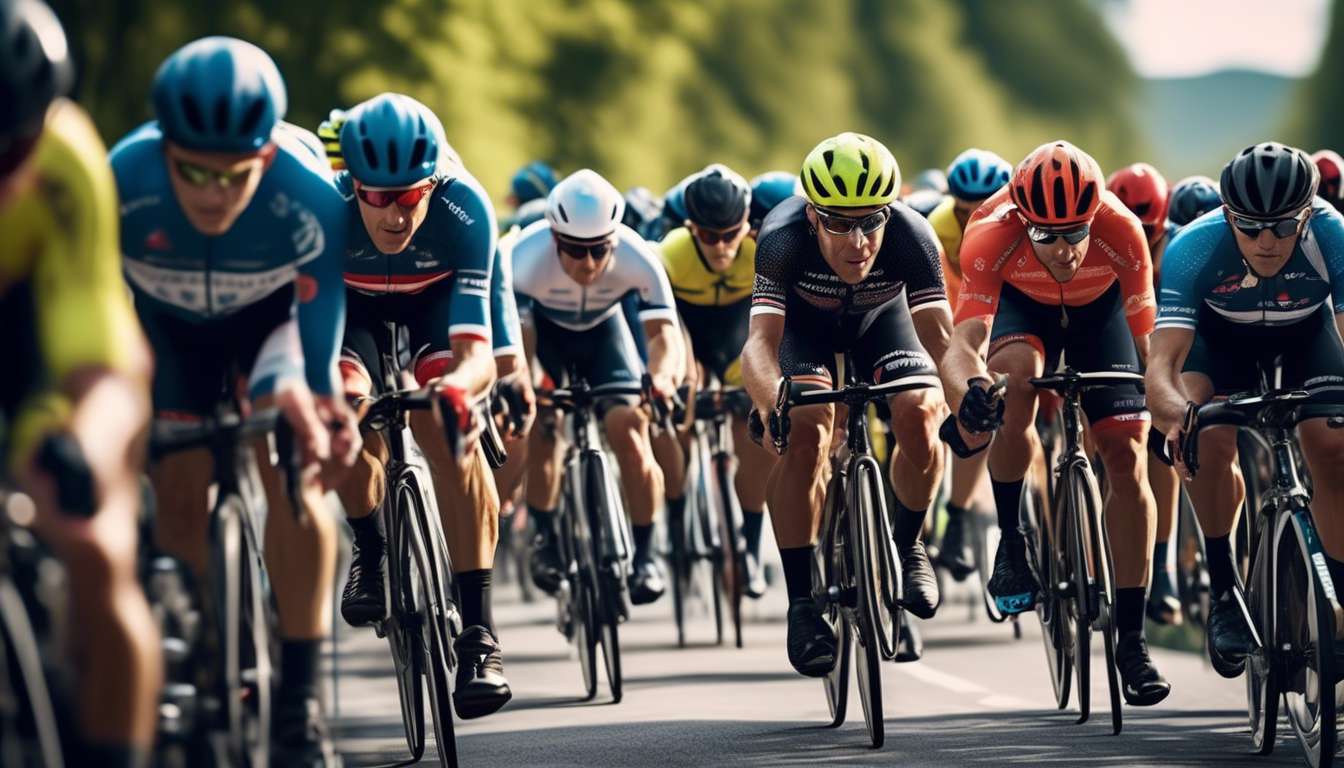As dedicated enthusiasts of the cycling world, we often find ourselves marveling at the strategies employed by professional bettors when it comes to cycling events. The thrill of the race, the unpredictable nature of the sport, and the sheer endurance required make cycling a unique challenge not just for the athletes but also for those who bet on their outcomes.
We are fascinated by the meticulous research and analysis that seasoned bettors engage in to gain an edge. This involves examining:
- The terrains
- Weather conditions
- Athletes’ performance histories
Together, we delve into the minds of these experts, exploring how they blend statistical insights with instinctive hunches to make informed decisions. By understanding their approach, we aim to uncover the art and science behind successful betting in the world of professional cycling.
Join us as we navigate this intricate landscape, hoping to glean knowledge from the best in the business.
Analyzing Race Routes
When analyzing race routes, we examine each course’s terrain, elevation, and potential weather conditions to predict outcomes. As a community of pro bettors, we understand that these factors significantly influence race strategy, rider performance, and team dynamics.
We meticulously study maps and profiles, knowing that a hilly route demands a different approach than a flat or mixed terrain. We share insights on how wind direction or sudden rain showers could alter the race’s complexion, making us feel connected through our shared expertise.
Our discussions often focus on how teams adapt their strategies to suit their riders’ strengths and weaknesses. We observe how a team might:
- Protect a star climber on a flat stage, saving energy for crucial ascents.
- Control the peloton’s pace to benefit a sprinter.
By understanding these dynamics, we enhance our sense of belonging in our betting community, united by our passion for cycling and the thrill of anticipating the race’s outcome.
Evaluating Climbing Abilities
Assessing Rider Climbing Abilities
We closely evaluate each rider’s climbing abilities by:
- Analyzing their past performances on similar terrains.
- Scrutinizing their current fitness levels.
This approach helps us develop a keen understanding of how they might perform in upcoming races.
Importance of Evaluating Climbing Prowess
Evaluating climbing prowess is crucial because:
- It often influences a team’s overall race strategy.
- It can significantly impact the race outcome.
We delve into rider performance statistics, looking for patterns or improvements that might provide an edge in mountainous stages.
Considering Team Dynamics
In addition to individual capabilities, we consider team dynamics:
- A strong support team can elevate a climber’s performance by pacing and providing tactical support during critical ascents.
- We observe how teams work together, noting whether they adopt aggressive tactics or a more conservative approach.
By understanding these dynamics, we better predict not only the rider’s success but also how they might contribute to their team’s overall objectives.
Holistic View for Informed Decisions
This holistic view is essential for making informed betting decisions, as it encompasses both individual abilities and team strategies.
Factoring in Sprinting Skills
Assessing Sprinting Skills
Evaluating sprinting skills involves examining both a rider’s top speed capabilities and their strategic positioning in a chaotic sprint finish. As bettors, we focus on:
- Navigating the Peloton: How a rider maneuvers through the group.
- Timing the Final Push: When and how they make their sprint.
A successful sprint is not solely about raw speed. It also requires:
- Anticipating Competitors’ Moves: Predicting what others will do.
- Exploiting Gaps: Taking advantage of openings in the peloton.
Understanding Race Strategy
Our community thrives on understanding race strategy. We analyze:
- Past Performances: Identifying riders who consistently excel in sprint finishes.
- Handling Pressure: Observing how riders manage stress and execute strategies during the final kilometers.
Team Dynamics
Individual performance is not isolated. Considerations include:
- Team Interaction: Understanding how a rider collaborates with their team.
- Leveraging Support: Utilizing team assistance to enhance sprint success.
Community Insights and Growth
We work collectively, sharing insights and experiences to improve our betting success. This collaboration fosters:
- A Sense of Belonging: Building a community.
- Mutual Growth: Enhancing our collective understanding and success.
Considering Team Dynamics
Team Dynamics in Cycling Events
We can’t overlook the crucial role that team dynamics play in shaping the outcome of a cycling event. As pro bettors, we recognize that a well-oiled team can significantly influence race strategy and rider performance.
Key Aspects of Team Dynamics:
-
It’s not just about individual talent; it’s about how riders work together, support one another, and execute a collective plan.
-
When a team operates in harmony, it can propel its leader to victory or defend against competitors, making understanding these dynamics essential.
Teamwork as a Game-Changer
In cycling, teamwork isn’t merely a bonus—it’s a game-changer. We analyze how teams strategize around their strengths, whether it’s setting up for a sprint finish or protecting a lead climber.
Roles and Execution:
- Each rider has a role to play.
- When they execute seamlessly, it can make or break the race.
Engagement with Team Dynamics
By diving into team dynamics, we’re not just spectators; we’re part of the community, living the race’s highs and lows. This understanding deepens our connection and enriches our betting insights.
Studying Rider Form
Understanding a rider’s form is crucial for pro bettors as it directly influences performance predictions and betting strategies.
We dive deep into several factors to gauge a rider’s current condition:
- Past performances
- Recent races
- Training updates
It’s not just about individual prowess; we also consider how race strategy and team dynamics can affect a rider’s performance. Key questions include:
- Are they the team’s lead or in a support role?
This shapes not just their motivation but also their physical exertion and tactical approach during a race.
Monitoring rider form involves:
- Observing their consistency
- Noting any recent improvements or declines
- Considering injuries and recovery periods
- Recognizing changes in coaching staff
These elements can signal shifts in a rider’s form.
As a community of bettors, sharing insights and analyses allows us to refine our understanding and make informed decisions. By staying connected and exchanging knowledge, we enhance our collective ability to predict outcomes.
It’s this shared commitment to detail that sets us apart in the competitive world of cycling betting.
Assessing Time Trial Prowess
Evaluating a rider’s time trial prowess involves analyzing several key components:
- Speed: Assessing how quickly a rider can complete the course.
- Stamina: Understanding their ability to maintain performance levels throughout the race.
- Technical Skills: Observing their efficiency and technique against the clock.
Race Strategy is a critical element where these components combine. A rider’s performance isn’t solely about raw power but about harnessing that power efficiently. It’s crucial to:
- Maintain stamina to sustain peak performance.
- Avoid burning out too soon.
Team Dynamics play an essential role even in what may seem like a solitary endeavor. The support and strategy from a skilled team can significantly impact the outcome. Key aspects include:
- Equipment choices that optimize performance.
- Pacing strategies that align with the rider’s strengths.
The team’s involvement extends to boosting the rider’s confidence and managing race-day logistics.
By meticulously analyzing these factors, we engage with a community of like-minded enthusiasts who appreciate the intricate dance of strategy and skill in cycling.
Reviewing Injury Histories
In reviewing injury histories, we delve into how past injuries might affect a rider’s current performance and future potential. It’s crucial to understand that even minor injuries can influence a rider’s race strategy and overall endurance.
We need to assess whether an injury has led to a shift in how a rider approaches climbs or sprints, which could directly impact their effectiveness on race day.
By examining injury records, we gain insights into a rider’s resilience and adaptability. This information helps us predict how a team might adjust its dynamics to compensate for a rider’s limitations or leverage their strengths.
When we spot a pattern of recurring injuries, it might indicate a vulnerability that could affect not just individual rider performance but also the team’s strategic cohesion.
We’re all in this together, analyzing these factors to make informed betting decisions. By understanding how injuries shape a rider’s journey, we can better anticipate outcomes and support our shared passion for cycling.
Incorporating Psychological Factors
Understanding the psychological factors at play in cycling is vital for predicting how riders will perform under pressure and adapt to race day challenges. Mental resilience can make or break a race strategy. It’s crucial to assess how riders handle:
- Stress
- Unexpected shifts in the race
- The pressure of competition
Some riders thrive under these conditions, while others may falter, affecting overall rider performance.
We can’t overlook the importance of team dynamics either. When a team’s morale is high, and communication is seamless, it:
- Strengthens the race strategy
- Boosts each rider’s confidence
In contrast, tension within the team can lead to a breakdown in strategy, negatively impacting performance. We’ve seen how unity and trust within a team can propel them to success, even in the toughest races.
By incorporating these psychological aspects into our analysis, we can make more informed predictions and, ultimately, better betting decisions. Together, we delve deeper and gain a comprehensive understanding of the race landscape.
How do professional bettors manage their bankroll when betting on cycling events?
When we wager on cycling events, we carefully manage our bankroll to ensure long-term success.
Key strategies include:
- Setting aside a specific portion of our funds for betting.
- Avoiding risky bets that could deplete our resources.
By sticking to a disciplined approach and making informed decisions, we aim to grow our bankroll steadily over time.
This method helps us maintain financial stability and continue enjoying the thrill of betting on cycling events.
What are the common betting markets available for cycling events?
When we bet on cycling events, common markets include:
- Race winner
- Top 3 finish
- Stage winner
- Head-to-head matchups
These markets help us diversify our bets and increase our chances of winning.
By understanding the dynamics of each market and analyzing the riders’ strengths and weaknesses, we can make informed decisions that lead to successful outcomes.
It’s important to:
- Keep track of odds.
- Stay updated on race developments.
This approach maximizes our betting opportunities.
How do pro bettors use weather forecasts to inform their cycling bets?
When we consider weather forecasts for cycling bets, we pay close attention to how they might impact the race dynamics.
Weather conditions like wind, rain, or extreme heat can greatly influence the outcome of a cycling event. By analyzing these forecasts, we can make more informed decisions on which cyclists might have an advantage or disadvantage based on their strengths and weaknesses in specific weather conditions.
Key weather factors to consider:
- Wind: Can affect drafting and energy expenditure.
- Rain: Impacts traction and can lead to more accidents.
- Extreme heat: Can lead to dehydration and impact performance.
By focusing on these elements, bettors can better evaluate potential outcomes and make strategic choices.
Conclusion
When approaching cycling events, pro bettors focus on several key factors to make informed decisions:
-
Analyze Race Routes: Understanding the specifics of the race route, including terrain and distance, is crucial.
-
Evaluate Climbing Abilities: Bettors assess which riders excel in climbing, especially for mountainous stages.
-
Factor in Sprinting Skills: Identifying top sprinters is important, particularly for flat and fast stages.
-
Consider Team Dynamics: The role of team support and strategies can significantly influence race outcomes.
-
Study Rider Form: Current fitness and performance levels of riders are analyzed to gauge potential success.
-
Assess Time Trial Prowess: Time trials are critical, so understanding which riders perform well individually is essential.
-
Review Injury Histories: Past injuries and recovery status can affect a rider’s performance and risk level.
-
Incorporate Psychological Factors: Mental toughness and motivation can impact a rider’s performance, especially under pressure.
By taking all these factors into account, pro bettors increase their chances of success in predicting outcomes and placing winning bets.




